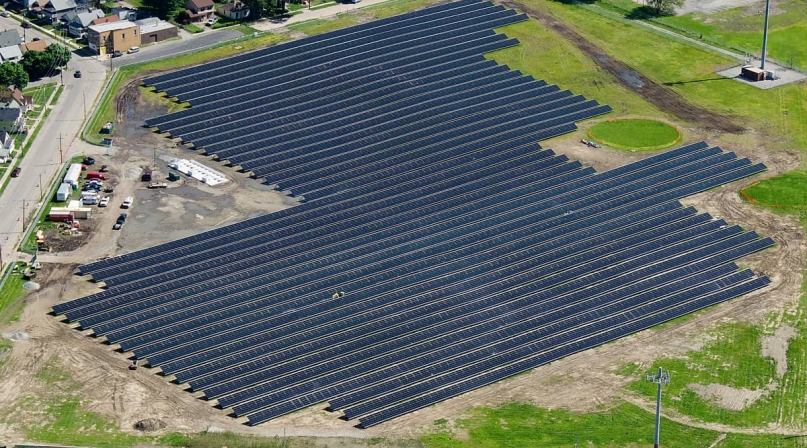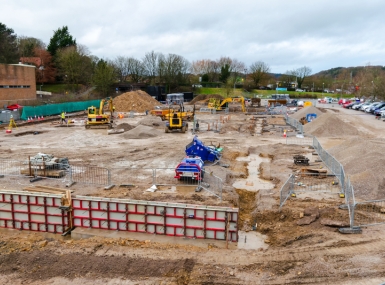Land banks rescue sliding tax bases, clear blight, stabilize communities

Land banks help counties save money on services, return real estate to tax rolls
For years, the empty Houghton Elevator Company factory greeted visitors to the Toledo Zoo. Offline since 1989, the hulking, vacant facility next door to the vibrant home of hundreds of exotic animals struck a stark contrast, and it didn’t look much better when the building was demolished, either, leaving a large vacant lot.
When describing the difficulty in using the brownfield site, The Toledo Blade described the scene as resembling a bomb blast or an air raid, with rubble everywhere and the property a hot potato juggled by a variety of owners who couldn’t get anything built there.
“It was vacant; it wasn’t going to be easy for anything to be done there, but it was right next to our major asset,” said David Mann, president of the Lucas County Land Bank. “If you were coming to the zoo, you’d see this vacant lot first.”
But in the course of nine months, by working with Mann’s land bank, GEM Energy had purchased the land and built a 20-acre solar array, which now provides half of the zoo’s energy.
“(GEM Energy) had their eyes on it, but what they didn’t have any real power to do was unwind significant delinquent tax issues and the other title issues on the land itself,” Mann said. “That’s the role we played. We were the catalyst to make this happen. Maybe they could have figured it out, but economically, they needed a fresh start in order to do this work.”
That ability to quickly settle delinquent tax bills and be a matchmaker for interested owners is what makes land banks an increasingly popular option for counties. Cities and municipalities can also form and operate land banks.
In addition to clean energy, the solar array is generating property tax revenue for Lucas County and represents a high profile example of what land banks can do. Since 2011, 10 states have passed legislation allowing for land banks, and counties that have made use of them have been able to save and generate money.
Under the radar
For every zoo-adjacent solar field, land banks are involved in dozens of lower-profile real estate transactions. They are more likely to be part of a deal to put a run-down house in the middle of a residential block into the hands of someone who wants to fix it up than to catch the at-large community’s eye with a big project. It could mean rehabilitating a home or demolishing it and selling it to a neighbor to add to their yard.
“You’ll find savings in stabilizing the tax base, and they grow the revenue base for communities where property has been neglected and abandoned,” said Chris Gulotta, a former redevelopment director in Cumberland County, Pa. As a private consultant, he has helped set up land banks in several Pennsylvania counties since 2012. “More immediately, you will see savings from the reduction of police and fire departments and code enforcement workers who don’t have to focus on those properties, because once the land banks have taken control they won’t be the magnets for criminal activity that they are when they’re vacant.”
The arson risk in vacant buildings is disproportionate to occupied buildings, Gulotta said. Studies have found that blighted properties can reduce property values within a two-block radius by up to 20 percent, making their remediation more than simply an aesthetic concern for their neighbors.
Whoever shows up to buy a tax-delinquent property could fix it up, but they could also not touch it and drain the equity further before giving up on it.
As effective as land banks are, Gulotta said, effective code enforcement is the best tool to prevent blight.
“There’s a return on investment in terms of reduction in the long-term of blighted properties to the extent that codes are enforced uniformly,” he said.
Ripe for redevelopment
Land banks are primarily an Eastern phenomenon, particularly in the Rust Belt owing to the age of its communities and the population drain from which many areas have not recovered.
“In the East, you see disinvestment that has resulted in a decline in the economic base of communities,” Gulotta said. “What land banks can do is make reuse happen with a little help.”
That help, of course, is contingent on money, and funding sources vary by state. New York seeded its land banks with money from the mortgage crisis restitution fund. Ohio generates land bank funding from a fee paid by tax delinquent property owners, making their land banks the envy of other states.
Erie County, N.Y.’s land bank, the Buffalo Erie Niagara Land Improvement Corporation (BENLIC), started off with $22 million, and the projects the bank funds are selected in part to help the bank remain viable despite the lack of dedicated funding. Since 2012, after demolishing or renovating nearly 150 properties, BENLIC has returned $5 million in assessed value back to the tax rolls.
“Every land bank makes a decision about what kind of properties it’s going to focus on,” said Executive Director Jocelyn Gordon. “Some decide they’re going to focus on the hardest-hit neighborhoods. We don’t work with farmlands or suburban properties on cul de sacs, we focus on city and village centers.”
Although entire properties in need can be clustered, addressing them first is not always the strategic option. “There are plenty of ‘war zones,’ but we can’t make a difference there,” she said. “But we can stabilize neighborhoods that are really on the brink, shore them up and spur new development.”
Successful completion of a few higher-end properties can both continue to fund the land bank’s operations and finance a project on a house that wouldn’t fetch nearly as much for resale. In New York, the proceeds from a land bank property’s sale are split between the land bank and the municipality to pay back property taxes. When BENLIC was formed, it was one of 10 New York land banks. Now there are 25, and the pie for funding has not grown.
“If one of our land banks across New York fails, it makes us all look bad,” Gordon said. “We really have to be sustainable and be cognizant about our long-term source of funding.”
The ideal property in Gordon’s eyes is close to a municipality’s main street, within walking distance of a business district, parks, schools and other services. BENLIC works with distressed property task forces from each municipality, which decide on properties and request the land bank’s assistance.
“We don’t choose the properties, we just decide whether to take the project,” she said. “We’re trying to make everybody else’s land use plans workable.”
Despite Buffalo’s population loss, there is a limited supply of the housing stock that is in demand — energy efficient, single-story houses that appeal across the age spectrum. When the opportunity to rehab or rebuild that kind of house presents itself, Gordon jumps at it.
Gulotta also sees a lot of potential in urban infill throughout Pennsylvania.
“Land banks in markets that are in transitional areas will find interest in market-rate housing in downtown areas from millennials in their 20s and 30s,” he said. “Once you have that residential base there’s a lot more commercial viability, but it all comes from the properties.”
Land banks have an advantage private developers don’t when it comes to acquiring properties: They can either take charge of a property before it goes to sheriff’s sale, or have a preferred bid that effectively ends the auction for that property.
“That’s one of the best parts of New York’s land bank legislation,” Gordon said. “The auction is fraught with risk, but with the preferred bids land banks have, we can guarantee a positive outcome.”
Bank on It
and banks developed following the suburban flight of the second half of the 20th century to create markets for tax-delinquent properties for redevelopment. They are government entities that can clear tax liens and hold property, contract work to improve or demolish the property and then sell it to generate payment for back taxes.
The initial set of land banks, in St. Louis, Cleveland, Louisville and Atlanta, were successful in using what Frank Alexander of the Center for Community Progress describes as relatively limited powers, but worked at lower capacities.
Genesee County, Mich. and Cuyahoga County, Ohio made up what Alexander calls the second generation of land banks in the early 2000s, which involved creating multi-jurisdictional entities and allowed them access to funding beyond the earlier land banks’ local-government-only funding, which allowed for expanded scopes of operation. They could now fund themselves with proceeds from property sales.
Since the great recession, 10 states have enacted land bank legislation: New York, Georgia, Missouri, Pennsylvania, Tennessee, Nebraska, Alabama, West Virginia, Delaware and Virginia. Rather than amending individual laws to create land banks, Alexander writes, these states enacted “template” legislation that often limited land banks to a single metropolitan area before expanding statewide.
Participating county, city and municipal governments appoint officers to land banks, who then enforce tax liens to acquire property. Given the intergovernmental relationships at play in setting up a land bank, a state typically must pass legislation creating land banking authority. If local governments have a strong range of home rule authority such as Cook County, they do not necessarily need state legislation to create a land bank.
Attachments
Related News

EPA announces up to $14 million for brownfields job training program
On July 23, the U.S. Environmental Protection Agency (EPA) announced its Notice of Funding Opportunity (NOFO) for $14 million through the Fiscal Year (FY) 2026 Brownfields Job Training Grants Program. This program helps communities impacted by brownfield sites—blighted, contaminated properties—build local workforces to support site cleanup and redevelopment.
Extreme sports attract crowds, help boost county tourism
Athletic events draw participants and spectators to counties featuring unique geographies that inspire feats of strength, endurance and creativity.
